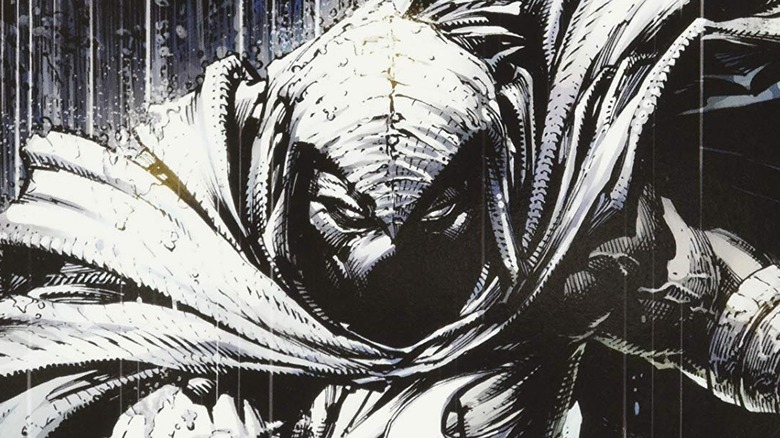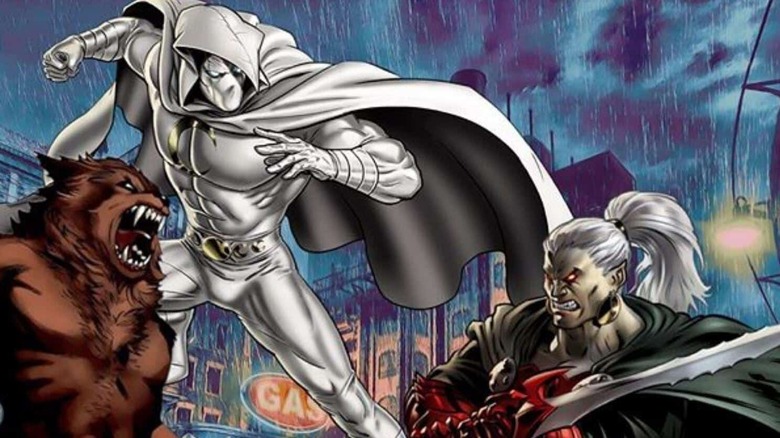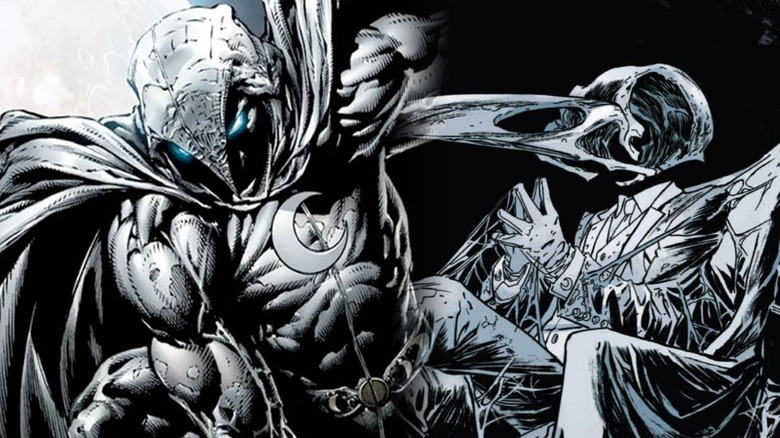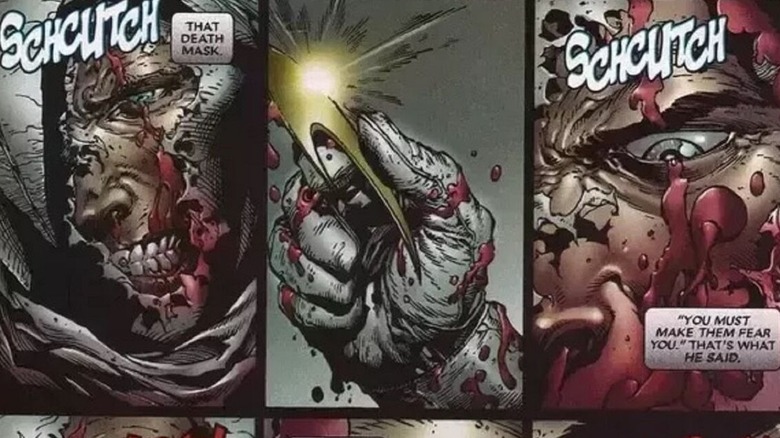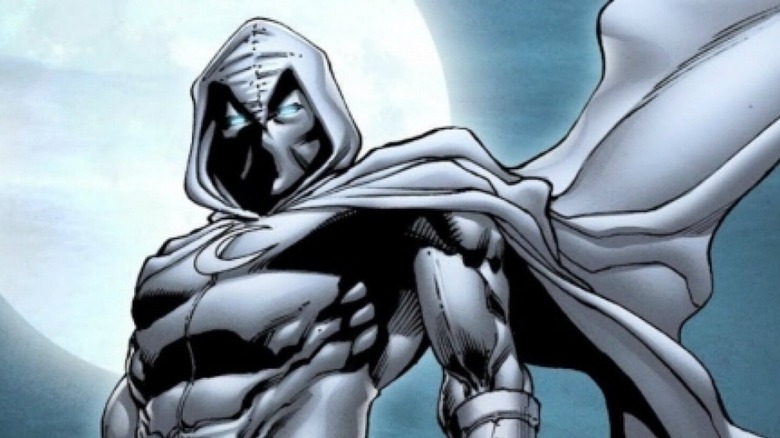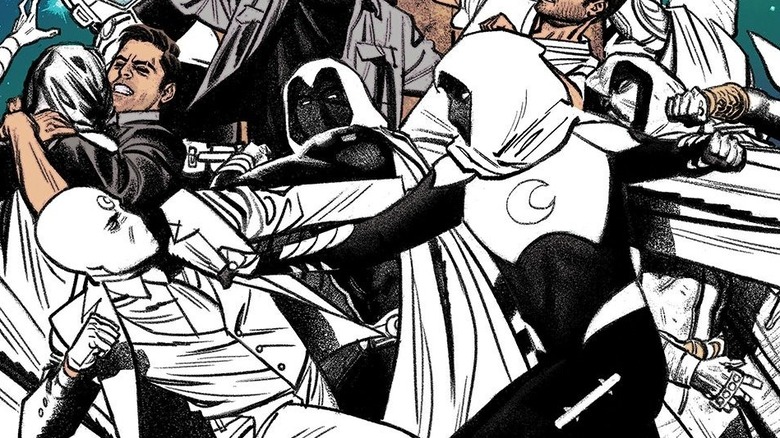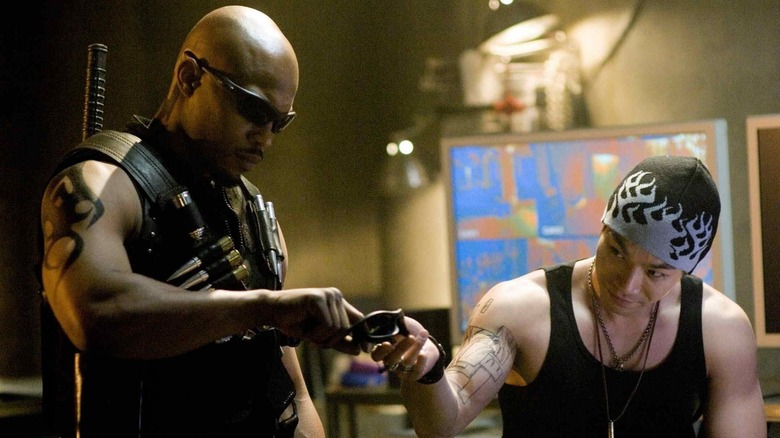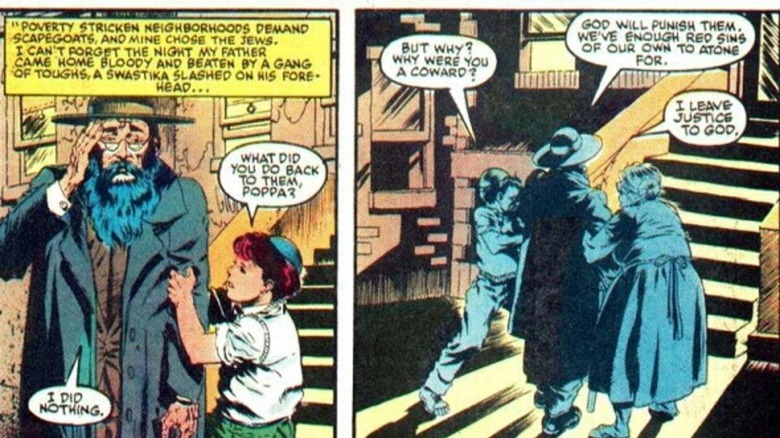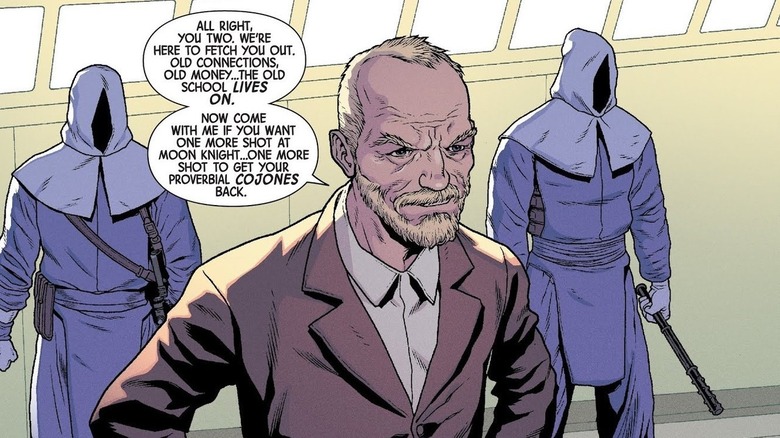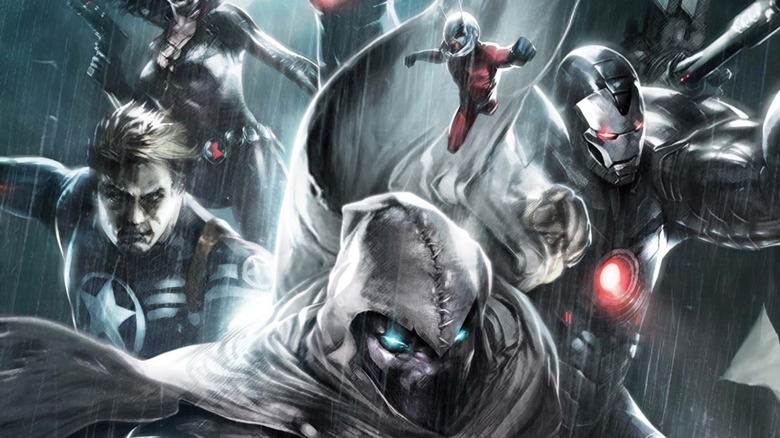10 Things You Didn't Know About Moon Knight
Can a tweet break the discourse? London's own Sunday Times tried its darnedest in early August, 2021. It postulated that the role of Tony Stark — a.k.a. Iron Man — could have been played by any actor in Jon Faverau's "Iron Man" and the picture would have still succeeded. Never mind that box-office mainstay Tom Cruise was attached to Iron Man before Robert Downey Jr., the question has now been raised: Could any actor have donned Shellhead's costume and made Marvel matter again?
The answer is complicated and, yes, relates to the forthcoming "Moon Knight" series on Disney+. The reality is that, in a post-"Avengers" Hollywood, actors are synonymous with their super-heroic characters. Tom Holland is Spider-Man. Mark Ruffalo is the Hulk. Actors breath life into their characters; for people who haven't read comics, they become them. And that may prove no truer than with Oscar Isaac and "Moon Knight."
Oscar Isaac is a powerhouse performer well known for both franchise and indie hits. Moon Knight is barely known to anyone. But even those familiar with the character would admit that Moon Knight represents a storytelling challenge, a character whose convoluted publication history and affecting backstory force both writers and audiences to engage on hyper-focused levels. The more you know about him going in? The better. With that, here are 10 things you didn't know about Moon Knight.
Moon Knight made his debut in 1975 ... as a villain
The annals of comics are filled with villains who develop a conscience and become do-gooders, but few begin their storied careers as lycanthrope-killing mercenaries. That was how Moon Knight — aka Marc Spector — was introduced, however, in the pages of "Werewolf by Night." Yes, Werewolf by Night! A character whose real name is Jack Russell and who has, as of this writing, had three more ongoing series than Rocket Raccoon.
Regardless, "Werewolf By Night" #35 finds a shadowy cabal called the Committee employing Moon Knight to capture the beast so that they may promptly weaponize him. The story proved popular enough that editors Marv Wolfman and Len Wein granted Moon Knight a solo story in the then-popular "Marvel Spotlight" #28 and #29, where his first appearance was retconned: Spector was undercover on his Werewolf-hunting mission, infiltrating the evil-doing Committee in the name of the Egyptian moon god Khonshu, whom he serves. Which is a relationship that necessitates further explanation...
Khonshu is a real Egyptian deity — and Moon Knight often serves him
The Marvel universe has a history of putting real religious figures into its comic books, and just as often making others up. In the case of Khonshu, the Egyptian god who Marc Spector occasionally worships, it's done a little of both.
"Khonshu" is the transliterated title of "Khonsu," an actual Egyptian deity whose name translates to "traveler," but can also mean "pathfinder" or "defender." It was said that Khonsu watched over and protected those who traveled at night. The first great son of Amun (one of the eight primordial Egyptian deities), Khonsu is the god of the Moon, fertility, and the passage of time. It tracks that such a powerful god might have a champion, and might imbue them with powers.
That said, most gods aren't driving their chosen warriors insane. The Khonshu of Marvel Comics lore has a distinctly comic-book vibe, one that informs the journey of Moon Knight from mercenary to madman and back again more than it canonizes an actual historical figure — which is important, given some of the actions that Marc Spector takes when he dons the moon-white cape and cowl.
Moon Knight once cut a man's face off
Moon Knight is often compared to DC Comics' Batman. Some of these comparisons are valid. They're both dark and brooding. They both pose as billionaires. But it can be said with absolute certainty that Bruce Wayne never cut a man's face off his skull. That, dear reader, is something Marc Spector did in the opening arc of Moon Knight's 2006 series — a book that found Marc Spector utterly broken.
The story, titled "The Bottom," opens on Spector at his lowest point. He is battling multiple addictions, has been abandoned by Khonshu, and has retired from crime-fighting permanently. The reason, as it turns out, is what he did to his nemesis Bushman the last time they fought. Namely: extreme disfigurement. It's a brutal sequence rendered all the more vivid by David Finch, whose electrically gritty art was an eerie and spot-on match for Houston's dark story. But Moon Knight's attack on Bushman was so shocking that it took a Warren Ellis-penned reboot of the character to reinvigorate more mainstream readers' interest in him. And speaking of writers...
Moon Knight's writers include an Edgar-winning crime writer and a beloved emo singer
It takes a radically empathic storyteller to tackle the inner life of Marc Spector, one who can balance Gothic and pulp sensibilities with a delicate take on life with a mental illness. Beyond that, said writer must have a flare for the dark and mystical. Enter Charlie Huston and Max Bemis.
Huston — who was responsible for the infamous Bushman-disfigurement scene — is most famous for his Henry Thompson trilogy, the first entry of which, "Caught Stealing," won an Edgar award for best paperback novel. His Marc Spector stories, while distinctly more violent than his novels, still blend the author's signature humor with an affection for life's castaways. Huston parlayed his 19-issue run on "Moon Knight" into other stories about Marvel's darkest characters, including the Punisher and Deathlok.
Bemis, on the other hand, was a completely outside the box choice for Moon Knight. The 37-year-old is best known as the lead singer, composer, and primary lyricist of the emo band Say Anything. The group's breakthrough release "...Is A Real Boy" garnered notoriety when, following the record's release, Bemis took an extended mental health break that affected his touring schedule. The musician's open discussion of both mental health and his Jewish heritage made him an inspired choice to pen stories for Moon Knight. We'll discuss why just a little later.
Moon Knight's initial origins fundamentally misrepresent Dissociative Identity Disorder
It is admirable, in theory, to create and write about a hero who struggles with mental health issues. It's de-stigmatizing; if a superpowered person can defeat the demons in their head as often as colorful villains, then anyone can. Moon Knight has Dissociative Identity Disorder, a condition affecting up to 1% of the population. His story could be healing for many.
Historically, that hasn't been the case. As Rosie Knight details in The Hollywood Reporter, Moon Knight's origin story fundamentally misunderstands DID. For Marc, having separate personalities (those of billionaire Steven Knight and cab driver Jake Lockley, for example) are a conscious decision. For most with DID? Not so. Furthermore, it wasn't made clear by Moon Knight creator Doug Moench if Marc Spector suffered from his ailment before getting powers, because of them, or something in between.
Based on the MCU's recent efforts to grapple with its protagonists' PTSD, depression, and other mental health issues, it's possible that the Disney+ Moon Knight show will take opportunities to clarify and correct Spector's origin the way the comics have. For now, we'll have to wait and see.
Moon Knight has manifested 10 separate personalities
That said, as Moon Knight himself has evolved in the pages of multiple ongoing series, so too have Moon Knight's myriad identities. And the 10 separate personas that Marc Spector has taken on — which range from the previously mentioned billionaire Steven Knight to Spider-Man himself — come closer to creating a sensitive portrait of a man afflicted with DID than the slate Moench started with.
Take August 2021's "Moon Knight" #2. It opens on Marc Spector in a new role, with a refined identity: that of a self-proclaimed priest running a mission for neighborhood locals. His new chosen occupation reveals itself further when he battles a malevolent mind-controller, tempting the villain to enter his mind and then rendering him numb with the all-consuming power of the Moon's sinister glory. It's a stunning sequence — and one that is quick to separate the effects of communion with Khonshu from Marc's ever-present DID. If the comics can evolve Marc Spector's personas, it's reasonable to assume that creators will continue to do so moving forward. That would be a welcome change, indeed.
Moon Knight was almost a television star once before
Remember "Blade: The Series?" Of course you don't! A short-running television series on Spike starring rapper Sticky Fingaz as the titular vampire hunter, "Blade: The Series" toyed with introducing other Marvel characters into its canon. One of those was Marc Spector, who was notably mentioned as a "werewolf expert" in its season-turned-series finale.
As it turned out, that wasn't just lip service; the name drop was meant to hint at already in-motion plans to introduce Moon Knight for Season 2, in anticipation of a separate Moon Knight show from No Equal Entertainment (of course, "Blade" was canceled after one season). And despite both James Gunn and Marvel Netflix guru Steven S. DeKnight revealing that they'd pitched a Moon Knight movie and wanted to tackle the character on television (respectively), it took until 2019 for a Moon Knight show to be announced.
Marc Spector is of Jewish heritage...
The Thing. Iceman. Legion. These are three of Marvel's 20-plus Jewish superheroes, another one of whom is Moon Knight himself. More than the above mentioned, however, Marc's faith and heritage factor into several of his most notable storylines.
For starters, Marc's father is a rabbi who practices anti-violence even after a gang of Nazis mercilessly carved a swastika into his forehead. That puts him at odds with Marc's budding perusal of a boxing career and eventual life as a mercenary. Years after the two disown each other, Marc saves an elderly man from a synagogue and, upon rescuing a Torah, is immediately reconnected with the Judaism he'd abandoned years prior.
As Josh Weiss eloquently observed in Forbes, this makes Moon Knight a true mensch, or one who experienced religious persecution and cannot let the act go unpunished any longer. It's a startling and lovely dimension to an already complex character, and one that was retconned into his other defining traits a few years ago.
...and his updated origin spotlights the psychological trauma the Jewish people suffered post-World War II
When Max Bemis began his run on Moon Knight, many assumed he would address the character's mental health history head on. Few anticipated, though, that he would make Moon Knight's psychological struggles an extended metaphor for the lingering horrors of World War II.
Bemis introduced Ernst (pictured above), a rabbi who grew close to Marc in his youth, to the Moon Knight canon. Marc regarded Ernst as an uncle — which made his discovery of a secret room in Ernst's synagogue all the more terrifying. Ernst, as it turned out, was a Nazi partially responsible for the creation of both the Red Skull and Hate Monger, and one who'd found the key to extending his life by stimulating the pleasure centers in his brain. What made Ernst happy? Horrifyingly, extending Hitler's final solution. Now in America, Ernst is a serial killer who targets Jewish people.
It's a terrifying hook for a villain and one that explicitly serves as a metaphor for the myriad of ways in which bigotry, traumatic stress, and the specters of grief and loss remained with multiple generations of Jews in America after World War II had ended. What's more, Bemis made it canon that Marc's DID manifested for the first time as he fought to escape Ernst, forever linking the origins of his condition to his battling spirit and his people's tragic history.
Moon Knight was an Avenger, fought the Avengers, and owes an Avenger his weapons
Not only did Moon Knight briefly fight alongside the West Coast Avengers early in his superhero career, but he became their antagonist in Jason Aaron's "Age Of Khonshu" storyline. The saga finds Moon Knight and Khonshu taking out Earth's mightiest heroes in the hopes of stopping Mephisto — which, as convoluted as it sounds, also seems like a tale easily adapted to the current MCU (see the thousands of different articles asking "Who is Mephisto in WandaVision?"). What's more, a popular MCU Avenger made Moon Knight's most popular weapons — none other than Clint Barton, aka Hawkeye.
In Marvel Comics lore, Moon Knight's iconic crescent-shaped darts are given to him by priests of Khonshu. Those darts, however, are explicitly based on Clint Barton's designs — in West Coast Avengers #22, Hawkeye and a handful of other heroes are transported back to 2940 BC and encounter early worshipers of the god who will give Moon Knight his powers. In exchange for their help, the vaulted archer makes darts, boomerangs, and throwing irons for Khonshu's followers. Centuries later, these are the exact same weapons bestowed on Moon Knight by Khonshu's current worshippers.
